
Date:
Location:
Speaker:
Abstract:
A longstanding challenge in molecular biomimicry is to build synthetic nanostructures with the same architectural sophistication as proteins. One of the most promising ways to do this is to synthesize sequence-defined, non-natural polymer chains that, like in Nature, spontaneously fold and assemble into precise three-dimensional structures. This was originally a synthesis problem, but the automated solid-phase submonomer synthesis method now allows one to efficiently synthesize high-purity, sequence-defined peptoid polymers up to and beyond 50 monomers in length. The method uses readily available primary amine synthons, allowing hundreds of chemically diverse sidechains to be cheaply introduced. This tremendous synthetic capability raised the next problem: which chemical sequences encode for precise folding into a particular 3D structure? This is essentially the protein folding problem extended to the non-natural world. Using our synthesis capabilities in concert with computational modeling and high-resolution characterization techniques, we demonstrate the design, synthesize, assembly and engineering of a variety of protein-mimetic nanostructures. We show by direct cryo-TEM imaging, AFM, NMR and x-ray scattering, that all known crystalline peptoid assemblies share a universal secondary structure motif, the cis-Sigma strand, based on a backbone fold containing all cis-amide bonds. This unexpected universality of peptoid backbone folding offers a unique opportunity to rationally design and engineer these materials to create robust, nanomaterials capable of protein-like functions, like specific molecular recognition and catalysis.
Bio:
Ronald Zuckermann received his B.S. in Chemistry in 1984 from Harvey Mudd College where he did undergraduate research in synthetic organic chemistry. He then went on to UC Berkeley to study Bioorganic Chemistry with Dr. Peter Schultz. His thesis work was on the synthesis of semi-synthetic nucleases capable of the sequence-specific cleavage of RNA. After receiving the first Schultz group Ph.D. in 1989, he became one of the founding chemists at Protos Corp., a combinatorial drug discovery start-up in Emeryville, CA. There he helped develop several key drug discovery technologies such as robotic combinatorial library synthesizers, affinity selection methods and a novel class of heteropolymers called "Peptoids". Chiron Corp. acquired Protos in 1991 where this work continued and was applied to small molecule drug discovery, new biomaterials and nucleic acid delivery. Dr. Zuckermann was promoted to Chiron Research Fellow in 2003. In early 2006, he left Chiron to join the Lawrence Berkeley National Laboratory, where he served as the Facility Director of the Biological Nanostructures Facility at The Molecular Foundry. He was promoted to Senior Scientist in 2011, and became a Researcher Emeritus in 2022. At LBL, he continues his quest to expand the application of peptoid polymers to mimic the structure and function of proteins, by folding peptoid sequences into defined nanoarchitectures. He has published over 180 papers and is co-inventor on 39 patents. Dr. Zuckermann currently serves on the external advisory board of the BioPacific MIP at UCSB.



